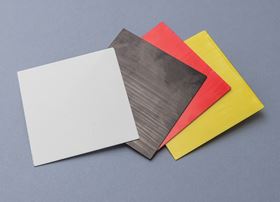New ceramic cools off in the sun

A significant breakthrough in developing a passive radiative cooling (PRC) material has been made by researchers at the City University of Hong Kong (CityU). They report their advance in a paper in Science.
The novel material, known as cooling ceramic, displays high-performance optical properties for energy-free and refrigerant-free cooling. Its cost-effectiveness, durability and versatility make it highly suitable for commercialization in numerous applications, particularly building construction.
By reducing the thermal load of buildings and providing stable cooling performance, in diverse weather conditions and all climates, cooling ceramic can enhance energy efficiency and help to combat global warming.
According to Chi-yan Tso, associate professor in the School of Energy and Environment (SEE) at CityU and one of the corresponding authors of the paper, PRC is considered one of the most promising green cooling technologies for curbing soaring demand for space cooling. However, current PRC technologies that use nanophotonic structures are limited by their high cost and poor compatibility with existing end uses, while polymeric photonic alternatives lack weather resistance and effective solar reflection.
“But our cooling ceramic achieves advanced optical properties and has robust applicability,” said Tso. “The color, weather resistance, mechanical robustness and ability to depress the Leidenfrost effect – a phenomenon that prevents heat transfer and makes liquid cooling on the hot surface ineffective – are key features ensuring the durable and versatile nature of the cooling ceramic.”
The cooling ceramic’s extraordinary abilities are due to its hierarchically porous structure, which is easily fabricated using highly accessible inorganic materials such as alumina through a simple two-step process involving phase inversion and sintering. No delicate equipment or costly materials are required, making the large-scale manufacturing of cooling ceramics highly feasible.
Optical properties determine the cooling performance of PRC materials in two wavelength ranges: the solar range (0.25–2.5µm) and the mid-infrared range (8–13µm). Efficient cooling requires high reflectivity in the former range to minimize solar heating and high emissivity in the latter range to maximize radiative heat dissipation. Owing to the high bandgap of alumina, the cooling ceramic keeps solar absorption to a minimum.
In addition, by mimicking the bio-whiteness of the Cyphochilus beetle and optimizing the porous structure, the cooling ceramic can efficiently scatter almost all the wavelengths of sunlight, resulting in near-ideal solar reflectivity of 99.6% (a record high solar reflectivity) and a high mid-infrared thermal emission of 96.5%. These advanced optical properties surpass those of current state-of-the-art materials.
“The cooling ceramic is made of alumina, which provides the desired UV resistance degradation, which is a concern typical of most polymer-based PRC designs,” said Tso. “It also exhibits outstanding fire resistance by withstanding temperatures exceeding 1000°C, which surpasses the capabilities of most polymer-based or metal-based PRC materials.”
Beyond its exceptional optical performance, the cooling ceramic also exhibits excellent weather resistance, chemical stability and mechanical strength, making it ideal for long-term outdoor use. At extremely high temperatures, the cooling ceramic exhibits superhydrophilicity, which causes immediate droplet spreading, while its interconnected porous structure helps to soak up the droplets. This superhydrophilic characteristic also inhibits the Leidenfrost effect, which hinders evaporation and is commonly found in traditional building envelope materials, leading to efficient evaporative cooling.
The Leidenfrost effect is a phenomenon that occurs when a liquid is brought into contact with a surface significantly hotter than its boiling point. Instead of immediately boiling away, the liquid forms a vapor layer that insulates it from direct contact with the surface. This vapor layer reduces the rate of heat transfer and makes liquid cooling on the hot surface ineffective, causing the liquid to levitate and skid across the surface.
“The beauty of the cooling ceramic is that it fulfils the requirements for both high-performance PRC and applications in real-life settings,” said Tso, adding that the cooling ceramic can be colored with a dual-layer design to meet aesthetic requirements.
“Our experiment found that applying the cooling ceramic on a house roof can achieve more than 20% electricity for space cooling, which confirms the great potential of cooling ceramic in reducing people’s reliance on traditional active cooling strategies and provides a sustainable solution for avoiding electricity grid overload, greenhouse gas emissions and urban heat islands.”
Tso and his research team now intend to advance further passive thermal management strategies. They aim to explore using these strategies to enhance energy efficiency, promote sustainability and increase the accessibility and applicability of PRC technologies in various sectors, including textiles, energy systems and transportation.
This story is adapted from material from the City University of Hong Kong, with editorial changes made by Materials Today. The views expressed in this article do not necessarily represent those of Elsevier. Link to original source.
Source link



